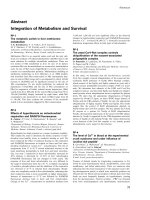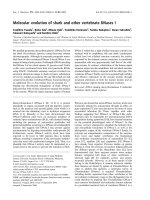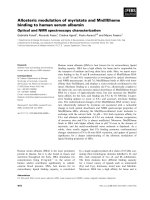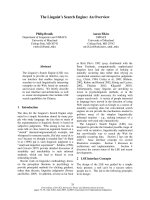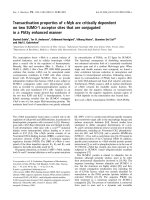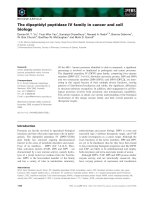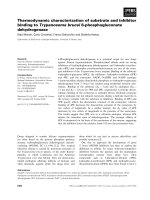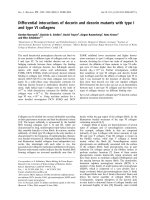Báo cáo khoa học: " The influence of smoking and other risk factors on the outcome after radiochemotherapy for anal cancer" ppt
Bạn đang xem bản rút gọn của tài liệu. Xem và tải ngay bản đầy đủ của tài liệu tại đây (265.9 KB, 7 trang )
BioMed Central
Page 1 of 7
(page number not for citation purposes)
Radiation Oncology
Open Access
Research
The influence of smoking and other risk factors on the outcome
after radiochemotherapy for anal cancer
Sabine Kathrin Mai*, Grit Welzel, Verena Haegele and Frederik Wenz
Address: Department of Radiation Oncology of the University Medical Center Mannheim, Germany
Email: Sabine Kathrin Mai* - ; Grit Welzel - ;
Verena Haegele - ; Frederik Wenz -
* Corresponding author
Abstract
Background: Smoking is an important risk factor for the development of cancer. Smoking during
radiochemotherapy therapy may have a negative influence on prognosis. We evaluated the effect
of smoking during radiochemotherapy on the outcome for patients with anal cancer.
Methods: Sixty-eight patients (34 smokers, 34 non-smokers) treated by radiochemotherapy for
anal cancer were analysed. The effect of smoking during radiochemotherapy and other risk factors
(gender, T- and N category, tumor site, dose, therapy protocol) on disease-specific survival (DSS),
local control (LC) and colostomy free survival (CFS) was evaluated.
Results: There was a significant difference in age and male:female ratio between the two groups.
With a median follow up of 22 months (max. 119) DSS, LC, and CFS were 88%, 84% and 84%. A
significant difference in local control between smokers (S) and non-smokers (NS) was found (S 74%
vs. NS 94%, p = .03). For DSS and CFS a difference in terms of outcome between smokers and non-
smokers was seen (DSS: S 82% vs. NS 96%, p = .19, CFS: S 75% vs. 91%, p = .15), which did not
reach statistical significance. In multivariate analyses only gender had a significant association with
LC and T category with CFS. The other risk factors did not reach statistical significance.
Conclusion: Even though our evaluation reached statistical significance only in univariate analysis,
we suggest, that the role of smoking during radiochemotherapy for anal cancer should not be
ignored. The potential negative effect on prognosis should be explained to patients before therapy.
Background
Smoking is one of the most important risk factors for the
development of several cancers, especially squamous cell
carcinoma [1]. In addition, smokers often have a worse
prognosis than non-smokers undergoing anti tumor ther-
apy [2-5]. On the one hand smokers often present with
more advanced tumor stages on the other hand smoking
especially during therapy seems to have a negative influ-
ence on the efficacy
of therapy. Browman et al. showed,
that patients with head and neck cancer, who smoked dur-
ing radiochemotherapy had significantly lower survival
rates than patients who stopped smoking [6].
Several studies revealed that beside HIV and HPV infec-
tion smoking is one of the most important risk factors for
anal cancer, especially in combination with virus infec-
tion. The risk of developing anal cancer is increased with
Published: 21 August 2007
Radiation Oncology 2007, 2:30 doi:10.1186/1748-717X-2-30
Received: 31 May 2007
Accepted: 21 August 2007
This article is available from: />© 2007 Mai et al; licensee BioMed Central Ltd.
This is an Open Access article distributed under the terms of the Creative Commons Attribution License ( />),
which permits unrestricted use, distribution, and reproduction in any medium, provided the original work is properly cited.
Radiation Oncology 2007, 2:30 />Page 2 of 7
(page number not for citation purposes)
the combination of one of these risk factors with smoking
[7-11].
Combined radiochemotherapy is the gold-standard in
treatment of anal cancer since Nigro et al reported their
data [12]. Local control rates of 60 – 90% over all stages
are achievable with sphincter preservation in about 65%
of the cases. There are some known factors influencing the
prognosis after combined radiochemotherapy for anal
cancer. Higher tumor stage and regional nodal involve-
ment are associated with an inferior prognosis. Also
tumor site in the anal canal seems to be associated with
unfavourable prognosis, but some authors found tumor
site at the anal margin as independent significant prog-
nostic factor for overall survival [13]. Several authors sug-
gest that the prognosis of female patients is superior to the
prognosis of male patients [14,15]. However, so far no
data about the influence of smoking on the prognosis of
anal carcinoma treated with primary combined radioche-
motherapy have been published to our knowledge. The
aim of this retrospective analysis was to evaluate the cor-
relation between smoking behaviour and other risk fac-
tors and the outcome in patients treated with
radiochemotherapy for anal cancer in a single center.
Methods
Between 1990 and 2006 a total of 90 patients were treated
with combined radiochemotherapy for anal cancer. Data
about smoking behaviour before and during therapy were
available from 73 patients. Five patients were lost to fol-
low up. Therefore 68 patients were included in this evalu-
ation. Thirty-four patients were non-smokers and 34
current smokers. Eight patients among the non-smokers
had stopped smoking more than 1 year before therapy.
One patient in the smoking group was HIV positive. Three
non-smokers and six smokers had complete tumor resec-
tion before therapy (2 APR, one in each group, and 7 local
excision (2 non smokers, 5 smokers)) and were treated in
adjuvant intention.
Patients' characteristics are displayed in Table 1.
The influence of smoking on the actuarial disease specific
survival (DSS), local control (LC), and colostomy-free sur-
vival (CFS) at 5 years was calculated. In addition the influ-
ence of other risk factors like gender, tumor site, tumor-
and nodal stage, radiation dose and therapy protocol on
these end points was evaluated.
Therapy
All patients were treated with combined radiochemother-
apy according to 3 different protocols (see Table 2). Treat-
ment was performed according to the Cummings protocol
until 1997, to the EORTC protocol from 1997 to 1999
and to the RTOG protocol since 1999. In each protocol
chemotherapy consists of a combination of Mitomycin C
bolus and 5FU continuous infusion. The protocol pub-
lished by Cummings et al. provided a total dose of 50 Gy
with a split course of 4 weeks, the EORTC protocol a total
dose of 59,4 Gy with a split course of 2 weeks and the
RTOG protocol a total dose of 50–54 Gy dependent on
the tumor stage without split.
Follow up
First follow up was performed 6 weeks after the end of
therapy and then every 3 months for the first 2 years and
Table 2: Therapy protocols
Protocol TD (Gy) SD (Gy) Chemotherapy Split
Cummings 48 – 50 1.8 – 2.5 MMC 10 mg/m2 d1
5FU 1000 mg/m2/24 h d1–5, 2 cycles 4 wks
EORTC 59,4 1.8 MMC 10 mg/m2 d1
5FU 200 mg/m2/24 h d1–26 + d1–13, 2 wks
RTOG 50–54 1.8 – 2 MMC 10 mg/m2 d1 + 29
5FU 1000 mg/m2/24 h d1–4 + 29–32 -
Table 1: Patients' characteristics
Smoker Non Smoker
n3434
mean age (range) 55 (34 – 77) 62 (38–86) p = 0.21
male:female 18:16 7:27 p = 0.006
Localisation ns
Anal canal 19 27
Anal verge 10 2
Overlapping 5 5
T-Stage ns
T1 3 7
T2 19 19
T3 10 3
T4 2 5
N-Stage ns
N 0 25 22
N + 9 12
Therapy Protocol ns
Cummings 3 3
EORTC 1 3
RTOG 30 28
Radiation Oncology 2007, 2:30 />Page 3 of 7
(page number not for citation purposes)
then every 6 months for 5 years. After 5 years annual
examinations were recommended. The follow up exami-
nations included physical examination, rectoscopy and
anorectal ultrasound and CT scan of the abdomen and
pelvis. A chest x-ray or CT-scan of the lung was performed
every 6 – 12 months. Local failure was defined as tumor
persistence within 3 months after therapy or histologically
verified recurrence beyond 3 months after therapy.
Statistical analysis
SPSS software, version 14.0.1 (SPSS Inc., Chicago, IL,
USA) was used for statistical analysis. Kaplan-Meier sur-
vival curves were generated and compared using the log-
rank test. Prognostic factors found to be significantly asso-
ciated with survival on univariate analysis were entered
into a multivariate Cox model using the stepwise back-
ward procedure. For all analyses a two-sided P-value of
<0.05 was considered statistically significant.
Results
Sixty-eight patients with complete data were eligible for
evaluation. Thirty-four patients were smokers and 34
patients non-smokers. Median follow up of the whole
group was 22 months (range: 2 – 119). Related to smok-
ing status there was no relevant difference in follow up
(smokers 24 months (min 2, max 119), non-smokers 22
months (min 2, max 111). Mean age of the smokers was
55 years (range: 34–77) and of the non-smokers 62 years
(38 – 86). The male:female ratio was significantly shifted
to males among the smokers (p = .006). Respective to
tumor localisation, tumor and nodal stage there was no
relevant difference between the two groups. Also there
was no difference in therapy protocol. Most patients in
both groups were treated according to the RTOG protocol.
(see Table 2).
Therapy
At the beginning of therapy 32 smokers and 31 non-
smokers were colostomy-free (smokers: 1 abdomino peri-
neal resection for anal cancer, 1 protective colostomy for
anal abscess, non-smokers 1 abdominoperineal resection
for anal cancer and 2 protective colostomies for anal
abscess or fistula). All patients except one non-smoker
received the planned total dose of radiotherapy. In this
case radiochemotherapy was stopped after first cycle of
chemotherapy at a dose of 43 Gy because of toxicity and
old age of the patient. The intensity of chemotherapy was
reduced in 1 smoker and 6 non-smokers due to hemato-
logic side effects. Most patients with therapy reductions
were treated according to the EORTC protocol.
Mean dose of radiotherapy was 51.9 Gy (43 – 59,4 Gy).
Eight patients received a total dose of less than 50 Gy.
Four patients had a complete tumor resection (2 APR and
2 excision) and were treated in adjuvant intention with a
dose of 45 Gy, one patient stopped therapy (43 Gy, see
above) and in 2 patients dose prescription was 49 Gy.
Disease specific survival (DSS)
Sixty-one patients were alive at the date of evaluation. 5
patients died disease related, 2 patients intercurrently
resulting in an actuarial DSS of 88%. The DSS of smokers
versus non-smokers was 82% vs. 96% (p = 0.19). Disease
specific survival had a significant association with tumor
stage (T1/2 97% vs T3/4 70% p = .016, log rank test) and
gender (male 74% vs. female 96% p = .013) (see Fig. 1, 2).
Because of the small number of tumor related deaths mul-
tivariate analysis was not meaningful.
Local Control (LC)
Ten patients suffered from recurrent disease. Two of these
patients had an anal carcinoma related to a giant condy-
loma Buschke-Löwenstein, 2 patients had anal cancer in
recurrent anal fistulas and abscesses because of chronic
inflammatory bowel disease, 1 patient had synchronic
renal cancer, 1 patient was permanently immunosup-
pressed because of Myasthenia gravis and one patient was
HIV positive. Tumor stages in these 10 patients were T1 n
= 1, T2 n = 4, T3 n = 4, T4 n = 1 and N+ n = 4. All recur-
rences appeared within the first 2 years after therapy. This
results in an actuarial local control rate at 5 years of 84%.
Local control had a significant association with smoking
(S 74% versus NS 94%, p = .03, log rank test) and gender
(male 66% vs. female 95%, p = .001, log rank test) (see
Fig. 3, 4). In multivariate analysis gender was the only var-
iable significantly determining local control. (see Table
3).
When local control calculated separately for males and
females, there was a difference between smoking and non
actuarial disease specific survival related T-stageFigure 1
actuarial disease specific survival related T-stage.
com
p
lete censored
0 1020304050607
disease specific survival, months
0
0,0
0,2
0,4
0,6
0,8
1,0
percent survival
T1/2
T3/4
p=0.16
Radiation Oncology 2007, 2:30 />Page 4 of 7
(page number not for citation purposes)
smoking females for local control with a strong tendency
towards significance (LC: NS 100% vs. S 87,5%, p = .054).
Among the males there was also a difference, but not
reaching statistical significance (LC: NS 71,4% vs. 66,7%,
p = 0.69).
Colostomy free survival (CFS)
63 patients were colostomy free at the beginning of ther-
apy. The actuarial colostomy free survival at 5 years was
84%. All colostomies were performed because of persist-
ent or recurrent disease, none was done for insufficient
sphincter function due to toxicity. Two patients had a sal-
vage abdomino-perineal resection and 3 patients pallia-
tive colostomy because of massive sphincter infiltration.
CFS of smokers versus non-smokers was 75% vs. 91% (p
= 0.15). In univariate log rank tests, T category was the
only significant prognostic factor for colostomy free sur-
vival. Colostomy free survival in patients with tumor stage
T1/2 was 96% versus 55% in patients with tumor stage
T3/4 (p = .000). (see Fig. 5) The other prognostic factors
showed no significant influence on colostomy free sur-
vival.
Other risk factors
The remaining risk factors like N stage, tumor localisation,
radiation dose and therapy protocol did not reach statisti-
cal significance.
Discussion
While smoking as a risk factor for the development of anal
cancer is well known, no data about the influence of
smoking during combined radiotherapy on the outcome
after therapy exist as of now. The exact role of smoking in
the etiology of anal cancer is still somewhat unclear. One
hypothesis is, that nicotine acts as a promoter for malig-
nant transformation in cells with HPV-DNA [16]. Phillips
et al. found elevated levels of DNA adducts in anal epithe-
lium of smokers [17]. Other potential aspects are the inhi-
bition of apoptosis or immunosupression caused by
smoking [18-22]. Smoking also is associated with higher
levels of carboxyhemoglobin resulting in tissue hypoxia.
Especially the inhibition of apoptosis and tissue hypoxia
may have an influence on the efficacy of radiochemother-
apy.
Browman et al. studied this effect in patients receiving
radio(chemo)therapy for head and neck cancer. They
found that smoking was an independent prognostic factor
for survival with a relative risk of 2.3. Also the smoking
history was identified as additional factor influencing sur-
actuarial local control related to genderFigure 4
actuarial local control related to gender.
com
p
lete censored
0 1020304050607
local control, months
0
0,0
0,2
0,4
0,6
0,8
1,0
percent survival
females
males
p=0.001
actuarial disease specific survival related to genderFigure 2
actuarial disease specific survival related to gender.
com
p
lete censored
0 10203040506070
0, 0
0, 2
0, 4
0, 6
0, 8
1, 0
percent survival
females
males
p=0.013
disease specif ic survival, months
actuarial local control related to smoking statusFigure 3
actuarial local control related to smoking status.
complete censor ed
0 102030405060
local control, months
70
0,0
0,2
0,4
0,6
0,8
1,0
per cent sur vival
NS
S
p=0.03
Radiation Oncology 2007, 2:30 />Page 5 of 7
(page number not for citation purposes)
vival [6]. In the follow up study from 2002 this effect
showed not longer statistical significance but in univariate
analysis there was still a survival difference favouring light
smokers vs. heavy smokers [23]. Several other studies also
found a significant effect on outcome for patients smok-
ing during radio/chemotherapy for non small cell and
small cell lung cancer [24,25].
As in the follow up study from Browman, in our study
smoking as prognostic factor did not reach statistical sig-
nificance in multivariate analysis for the limit of the retro-
spective study. In log rank tests smokers had significantly
more local failures than non smokers and also for disease
specific survival and colostomy free survival there was a
trend toward better outcome for non smokers. Overall the
number of tumor related deaths and colostomies in our
study was small because of the good prognosis of anal
cancer after combined radiochemotherapy. According to
the retrospective character of our evaluation we only had
information, whether the patients smoked or not and
when they stopped smoking. No exact quantitative data
about the number of smoked cigarettes or pack years were
available. One may speculate whether with a larger
number of patients and more detailed quantitative infor-
mation smoking might turn out as an independent prog-
nostic factor in multivariate analysis.
We found gender as independent prognostic factor for
local control and disease free survival in multivariate anal-
ysis. There was no difference in tumor- or therapy related
factors between males and females, but the male:female
ratio was shifted towards a higher number of males
among the smokers. The role of gender in the prognosis of
anal cancer remains still unclear. Some series and our data
suggest, that men suffering from anal cancer have a poorer
prognosis than woman [14,26], whereas others did not
[27-29].
When local control of males and females was calculated
separately, we saw a difference among female smokers
and non smokers with a strong tendency to better progno-
sis of non smoking females. None of the female non
smokers suffered from local recurrence. Also among males
there was a difference not reaching statistical significance,
caused by the small number of male patients at all and
non smoking males. We think both, gender and smoking
have influence on local control, although we could not
demonstrate significance on the basis of our data. One
may speculate that the imbalanced distribution of gender
in both groups diminish our ability to detect the potential
independent effect of smoking during radiochemother-
apy for anal cancer. This should be evaluated in future
studies.
T stage and tumor size are well known as prognostic fac-
tors for anal cancer [30]. In our analysis T stage had a sig-
actuarial colostomy free survival related to t-stageFigure 5
actuarial colostomy free survival related to t-stage.
com
p
lete censored
0 102030405060
colostomy free survival, months
70
0,0
0,2
0,4
0,6
0,8
1,0
percent survival
T1/2
T3/4
p=0.000
Table 3: Results of the Cox regression analysis (stepwise backward procedure)
Variable Score Coeffizient SE HR 95% CI P
(a) Step 1
Gender
Male (n = 25) 1 1.81 0.82 6.08 1.23–30.15 0.027
Female (n = 43) 0
Smoking
Yes (n = 34) 1 1.01 0.82 2.75 0.55–13.64 0.217
No (n = 34) 0
(b) Step 2
Gender
Male (n = 25) 1 2.09 0.79 8.12 1.72–38.32 0.008
Female (n = 43) 0
Abbreviations: SE – Standard Error, HR – Hazard Ratio, CI-Confidence Intervall
Radiation Oncology 2007, 2:30 />Page 6 of 7
(page number not for citation purposes)
nificant association with DSS and CFS, but not with local
control, which may be explained by the small number of
recurrences among our patients.
The other evaluated risk factors, in particular N category
and tumor site showed no significant prognostic effect.
Especially N category is often addressed as a prognostic
factor for survival [15,27]. However, other studies also
found no significant effect of nodal status [28,31] which
may be caused by the heterogeneous treatment modalities
in the respective studies. Also we found no difference
between the three treatment protocols. On the other hand
only 10 patients were treated outside the RTOG protocol
and the differences between the three protocols in dose
and chemotherapy are only marginal.
Conclusion
In conclusion, even though our evaluation showing a neg-
ative influence of smoking on outcome reached statistical
significance only in univariate analysis, we suggest, that
the role of smoking during radiochemotherapy for anal
cancer should not be ignored. Therefore the negative
effect that smoking might have on their prognosis should
be explained to patients before therapy.
Abbreviations
DSS- Disease specific survival
LC- Local control
CFS- Colostomy free survival
S- Smoker
NS- Non-smoker
Competing interests
The author(s) declare that they have no competing inter-
ests.
Authors' contributions
SM participated in the conception and design of the study,
SM, GW and VH collected the data. SM and GW per-
formed the statistical evaluation. FW participated in
design of the study and revised the manuscript.
References
1. Falk RT, Pickle LW, Brown LM, Mason TJ, Buffler PA, Fraumeni JF Jr.:
Effect of smoking and alcohol consumption on laryngeal can-
cer risk in coastal Texas. Cancer Res 1989, 49:4024-4029.
2. Shaw HM, Milton GW: Smoking and the development of
metastases from malignant melanoma. Int J Cancer 1981,
28:153-156.
3. Archimbaud E, Maupas J, Lecluze-Palazzolo C, Fiere D, Viala JJ: Influ-
ence of cigarette smoking on the presentation and course of
chronic myelogenous leukemia. Cancer 1989, 63:2060-2065.
4. Bako G, Dewar R, Hanson J, Hill G: Factors influencing the sur-
vival of patients with cancer of the prostate. Can Med Assoc J
1982, 127:727-729.
5. Hinds MW, Yang HY, Stemmermann G, Lee J, Kolonel LN: Smoking
history and lung cancer survival in women. J Natl Cancer Inst
1982, 68:395-399.
6. Browman GP, Wong G, Hodson I, Sathya J, Russell R, McAlpine L,
Skingley P, Levine MN: Influence of cigarette smoking on the
efficacy of radiation therapy in head and neck cancer. N Engl
J Med 1993, 328:159-163.
7. Frisch M, Glimelius B, Wohlfahrt J, Adami HO, Melbye M: Tobacco
smoking as a risk factor in anal carcinoma: an antiestrogenic
mechanism? J Natl Cancer Inst 1999, 91:708-715.
8. Tseng HF, Morgenstern H, Mack TM, Peters RK: Risk factors for
anal cancer: results of a population-based case control
study. Cancer Causes Control 2003, 14:837-846.
9. Moore TO, Moore AY, Carrasco D, Vander Straten M, Arany I, Au
W, Tyring SK: Human papillomavirus, smoking, and cancer. J
Cutan Med Surg 2001, 5:323-328.
10. Daling JR, Madeleine MM, Johnson LG, Schwartz SM, Shera KA, Wur-
scher MA, Carter JJ, Porter PL, Galloway DA, McDougall JK: Human
papillomavirus, smoking, and sexual practices in the etiology
of anal cancer. Cancer 2004, 101:270-280.
11. Daling JR, Sherman KJ, Hislop TG, Maden C, Mandelson MT, Beck-
mann AM, Weiss NS: Cigarette smoking and the risk of ano-
genital cancer. Am J Epidemiol 1992, 135:180-189.
12. Nigro ND, Vaitkevicius VK, Considine B Jr.: Combined therapy for
cancer of the anal canal: a preliminary report. Dis Colon Rectum
1974, 17:354-356.
13. Grabenbauer GG, Kessler H, Matzel KE, Sauer R, Hohenberger W,
Schneider IH: Tumor site predicts outcome after radiochem-
otherapy in squamous-cell carcinoma of the anal region:
long-term results of 101 patients. Dis Colon Rectum 2005,
48:1742-1751.
14. Goldman S, Glimelius B, Glas U, Lundell G, Pahlman L, Stahle E: Man-
agement of anal epidermoid carcinoma an evaluation of
treatment results in two population-based series. Int J Color-
ectal Dis 1989, 4:234-243.
15. Cummings BJ, Keane TJ, O'Sullivan B, Wong CS, Catton CN: Epider-
moid anal cancer: treatment by radiation alone or by radia-
tion and 5-fluorouracil with and without mitomycin C. Int J
Radiat Oncol Biol Phys 1991, 21:1115-1125.
16. Garrett LR, Perez-Reyes N, Smith PP, McDougall JK: Interaction of
HPV-18 and nitrosomethylurea in the induction of squamous
cell carcinoma. Carcinogenesis 1993, 14:329-332.
17. Phillips DH, Hewer A, Scholefield JH, Skinner P: Smoking-related
DNA adducts in anal epithelium. Mutat Res 2004, 560:167-172.
18. Hughes DA, Haslam PL, Townsend PJ, Turner-Warwick M: Numer-
ical and functional alterations in circulatory lymphocytes in
cigarette smokers. Clin Exp Immunol 1985, 61:459-466.
19. Wright SC, Zhong J, Zheng H, Larrick JW: Nicotine inhibition of
apoptosis suggests a role in tumor promotion. Faseb J 1993,
7:1045-1051.
20. Wright SC, Zhong J, Larrick JW: Inhibition of apoptosis as a
mechanism of tumor promotion. Faseb J 1994, 8:654-660.
21. Poppe WA, Peeters R, Drijkoningen M, Ide PS, Daenens P, Lauweryns
JM, Van Assche FA: Cervical cotinine and macrophage-Langer-
hans cell density in the normal human uterine cervix. Gynecol
Obstet Invest 1996, 41:253-259.
22. Poppe WA, Ide PS, Drijkoningen MP, Lauweryns JM, Van Assche FA:
Tobacco smoking impairs the local immunosurveillance in
the uterine cervix. An immunohistochemical study. Gynecol
Obstet Invest 1995, 39:34-38.
23. Browman GP, Mohide EA, Willan A, Hodson I, Wong G, Grimard L,
MacKenzie RG, El-Sayed S, Dunn E, Farrell S: Association between
smoking during radiotherapy and prognosis in head and neck
cancer: a follow-up study. Head Neck 2002, 24:1031-1037.
24. Johnston-Early A, Cohen MH, Minna JD, Paxton LM, Fossieck BE Jr.,
Ihde DC, Bunn PA Jr., Matthews MJ, Makuch R: Smoking absti-
nence and small cell lung cancer survival. An association.
Jama 1980, 244:2175-2179.
25. Tsao AS, Liu D, Lee JJ, Spitz M, Hong WK: Smoking affects treat-
ment outcome in patients with advanced nonsmall cell lung
cancer. Cancer 2006, 106:2428-2436.
26. Frost DB, Richards PC, Montague ED, Giacco GG, Martin RG: Epi-
dermoid cancer of the anorectum. Cancer 1984, 53:1285-1293.
Publish with BioMed Central and every
scientist can read your work free of charge
"BioMed Central will be the most significant development for
disseminating the results of biomedical research in our lifetime."
Sir Paul Nurse, Cancer Research UK
Your research papers will be:
available free of charge to the entire biomedical community
peer reviewed and published immediately upon acceptance
cited in PubMed and archived on PubMed Central
yours — you keep the copyright
Submit your manuscript here:
/>BioMedcentral
Radiation Oncology 2007, 2:30 />Page 7 of 7
(page number not for citation purposes)
27. Belkacemi Y, Berger C, Poortmans P, Piel G, Zouhair A, Meric JB,
Nguyen TD, Krengli M, Behrensmeier F, Allal A, De Looze D, Bernier
J, Scandolaro L, Mirimanoff RO: Management of primary anal
canal adenocarcinoma: a large retrospective study from the
Rare Cancer Network. Int J Radiat Oncol Biol Phys 2003,
56:1274-1283.
28. Nilsson PJ, Svensson C, Goldman S, Ljungqvist O, Glimelius B: Epi-
dermoid anal cancer: a review of a population-based series of
308 consecutive patients treated according to prospective
protocols. Int J Radiat Oncol Biol Phys 2005, 61:92-102.
29. Peiffert D, Seitz JF, Rougier P, Francois E, Cvitkovic F, Mirabel X,
Nasca S, Ducreux M, Hannoun-Levi JM, Lusinchi A, Debrigode E,
Conroy T, Pignon JP, Gerard JP: Preliminary results of a phase II
study of high-dose radiation therapy and neoadjuvant plus
concomitant 5-fluorouracil with CDDP chemotherapy for
patients with anal canal cancer: a French cooperative study.
Ann Oncol 1997, 8:575-581.
30. Touboul E, Schlienger M, Hadjrabia S, Laugier A: [Cancer of the
anal canal; role of radiotherapy and combinations of chemo-
therapy and radiotherapy]. Rev Med Interne 1993, 14:340-349.
31. Akbari RP, Paty PB, Guillem JG, Weiser MR, Temple LK, Minsky BD,
Saltz L, Wong WD: Oncologic outcomes of salvage surgery for
epidermoid carcinoma of the anus initially managed with
combined modality therapy. Dis Colon Rectum 2004,
47:1136-1144.

